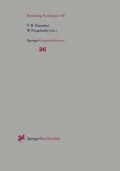Abstract
In this paper, an extension to the radiosity method, for the simulation of daylight, is presented. The sky hemisphere around the scene is subdivided into a set of sky patches. By defining a location on the earth, a time of day and the weather conditions (e.g., clear sky, overcast, partly cloudy) a sky model (e.g., CIE or Perez) is applied to compute the radiosity values for each sky patch. In a radiosity preprocess, the sky patches are regarded as shooting patches and are treated first. By storing the form factors within this preprocess, all parameters of the sky model can be modified and updated very quickly. Thus, a designer can see the lighting variation throughout a typical day by calling the costly form factor computation only once.
Access this chapter
Tax calculation will be finalised at checkout
Purchases are for personal use only
Preview
Unable to display preview. Download preview PDF.
References
Campbell A.T., Fussell D.S., “Adaptive Mesh Generation for Global Diffuse Illumination”, ACM Computer Graphics (SIGGRAPH ’90 Proceedings), Vol. 24, No. 3, August 1990, pp. 155–164.
CIE Technical Committee 4.2. Standardization of luminance on clear skies. CIE Publication No. 22, Commission International de l’clairaze, Paris, 1973.
Cohen M.F., Greenberg D.P.: “The Hemi-Cube: A Radiosity Solution for Complex Environments”, ACM Computer Graphics (SIGGRAPH ’85 Proceedings), Vol. 19, No. 3, July 1985, pp. 31–40.
Cohen M.F., Greenberg D.P., Immel D.S., Brock P.J.: “An Efficient Radiosity Approach for Realisitic Image Synthesis”, IEEE CG&A, Vol. 6, No. 2, March 1986, pp. 26–35.
Dobashi Y., Kaneda K., Nakashima T., Yamashita H., Nishita T., Tadamura K.: “Skylight for Interior Lighting Design”, Computer Graphics Forum (EUROGRAPHICS ’94), Vol. 13, No. 3, 1994, pp. C-85–C-96.
Gatenby N.: Optimising Discontinuity Meshing Radiosity, ph. d thesis at the University of Manchester, 1995.
Hanrahan P., D. Salzman, L. Aupperle: “A Rapid Hierarchical Radiosity Algorithm”, ACM Computer Graphics (SIGGRAPH VI Proceedings), Vol. 25, No. 4, July 1991, pp. 197–206.
Lischinski D., Tampieri F., Greenberg D.P.: “Combining Hierarchical Radiosity and Discontinuity Meshing”, ACM Computer Graphics (SIGGRAPH ’93 Proceedings), Vol. 24, No. 3, August 1993, pp. 199–208.
Lischinski D., Tampieri F., Greenberg D.P.: “Discontinuity Meshing for Accurate Radiosity”, IEEE CG&A, Vol. 12, No. 6, November 1993, pp. 25–39.
Nimeroff J.S., Simoncelli E., Dorsey J.: “Efficient Re-rendering of Naturally Illuminated Environments”, in Fifth Eurographics Workshop on Rendering ( Darmstadt, Germany, June 1995 ), pp. 359–373.
Nishita T., Nakamae E.: “Continuous Tone Representation of Three-Dimensional Objects Illuminated by Sky Light”, ACM Computer Graphics (SIGGRAPH ’86 Proceedings), Vol. 20, No. 4, August 1986, pp. 125–132.
Perez R., Seals R., Michalsky J.: “All-Weather Model for Sky Luminance Distribution — Preliminary Configuration and Validation”, Solar Energy, Vol. 50, No. 3, 1993, pp. 235–245.
Tadamura K., Nakamae E., Kaneda K., Baba M., Yamashita H., Nishita T.: “Modeling of Skylight and Rendering of Outdoor Scenes”, Computer Graphics Forum (EUROGRAPHICS ’93), Vol. 12, No. 3, 1993, pp. C-189–C-200.
Tregenza P.R.: “Subdivision of the sky hemisphere for luminance measurements”, Lighting Research and Technology, Vol. 19, 1987, pp. 13–14.
Wallace, John R., Kells A. Elmquist, Eric A. Haines: “A Ray Tracing Algorithm For Progressive Radiosity,” ACM Computer Graphics (SIGGRAPH ’89 Proceedings), Vol. 23, No. 3, July 1989, pp. 315–324.
Ward G.J.: “The radiance lighting simulation system”, SIGGRAPH ’92 Global Illumination Course Notes, ACM Press, July 1992.
Author information
Authors and Affiliations
Editor information
Editors and Affiliations
Rights and permissions
Copyright information
© 1995 Springer-Verlag/Wien
About this paper
Cite this paper
Müller, S., Kresse, W., Gatenby, N., Schöffel, F. (1995). A radiosity approach for the simulation of daylight. In: Hanrahan, P.M., Purgathofer, W. (eds) Rendering Techniques ’95. EGSR 1995. Eurographics. Springer, Vienna. https://doi.org/10.1007/978-3-7091-9430-0_14
Download citation
DOI: https://doi.org/10.1007/978-3-7091-9430-0_14
Published:
Publisher Name: Springer, Vienna
Print ISBN: 978-3-211-82733-8
Online ISBN: 978-3-7091-9430-0
eBook Packages: Springer Book Archive

